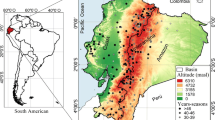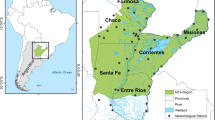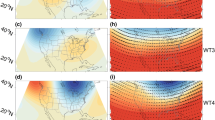Abstract
Extremely high autumn and winter precipitation events on the European west coast are often driven by low-pressure systems in the North Atlantic. Climate projections suggest the number and intensity of these events is likely to increase far more than the mean precipitation. In this study we investigate the autumn-winter extreme precipitation on the Norwegian west coast and the connection between its spatial distribution and sea level pressure (SLP) patterns using the k-means cluster analysis. We use three relatively high resolved downscalings of one global coupled model: the Arpège global atmospheric model (stretched grid with 35-km horizontal resolution over Norway) and the WRF-downscaled Arpège model (30 and 10-km) for the 30-year periods of 1961–1990 and 2021–2050. The cluster analysis finds three main SLP patterns responsible for extreme precipitation in different parts of the country. The SLP patterns found are similar to the NAO positive pattern known to strengthen the westerly flow towards European coast. We then apply the method to investigate future change in extreme precipitation. We find an increase in the number of days with extreme precipitation of 15, 39 and 35% in the two simulations (Arpège 35-km and WRF 30 and 10-km, respectively). We do not find evidence of a significant change in the frequency of weather patterns between the present and the future periods. Rather, it is the probability of a given weather pattern to cause extreme precipitation which is increased in the future, probably due to higher temperatures and an increased moisture content of the air. The WRF model predicts the increase in this probability caused by the most important SLP patterns to be >50%. The Arpège model does not predict such a significant change because the general increase in extreme precipitation predicted is smaller, probably due to its coarser resolution over ocean which leads to smoother representation of the low pressure systems.





Similar content being viewed by others
References
Boberg F, Berg P, Thejll P, Gutowski WJ, Christensen JH (2010) Improved confidence in climate change projections of precipitation further evaluated using daily statistics from ENSEMBLES models. Clim Dyn 35:1509–1520. doi:10.1007/s00382-009-0683-8
Christensen JH, Christensen OB (2007) A summary of the PRUDENCE model projections of changes in European climate by the end of the century. Clim Change 81(suppl 1):7–30. doi:10.1007/s10584-006-9210-7
Déqué M, Piedelievre JP (1995) High resolution climate simulation over Europe. Clim Dyn 11:321–339
Dorling SR, Davies TD, Pierce CE (1992) Cluster analysis: a technique for estimating the synoptic meteorological controls on air and precipitation chemistry—method and applications. Atmos Environ 26:2575–2581
Fovell R-G, Fovell M-YC (1993) Climate zones of the conterminous United States defined using cluster analysis. J Clim 6:2103–2135
Hanssen-Bauer I, Førland E (2000) Temperature and precipitation variations in Norway 1900–1994 and their links to atmospheric circulation. Int J Climatol 20:1693–1708
Hanssen-Bauer I (2005) Regional temperature and precipitation series for Norway: analyses of time-series updated to 2004. Norwegian Meteorological Institute Report 15/2005, Oslo
Haugen JE, Iversen T (2008) Response in extremes of daily precipitation and wind from a downscaled multi-model ensemble of anthropogenic global climate change scenarios. Tellus 60:411–426
Heikkilä U, Sandvik AD, Sorteberg A (2010) Dynamical downscaling of ERA-40 in complex terrain using the WRF regional climate model. Clim Dyn. doi:10.1007/s00382-010-0928-6
Hurrell JW (1995) Decadal trends in the North Atlantic oscillation: regional temperatures and precipitation. Science 269:676–679
Hurrell JW, van Loon H (1997) Decadal variations in climate associated with the North Atlantic oscillation. Clim Change 36:301–326
Hurrell JW, Deser C (2009) North Atlantic climate variability: the role of the North Atlantic oscillation. J Mar Syst 78:28–41
Intergovernmental Panel on Climate Change (2007) Fourth Assessment Report (AR4), Chapter 11
Kaufmann P, Whitemann CD (1999) Cluster-analysis classication of wintertime wind patterns in the grand canyon region. J Appl Met 38:1131–1147
Kharin VV, Zwiers FW, Zhang X, Hegerl GC (2007) Changes in temperature and precipitation extremes in the IPCC ensemble of global coupled model simulations. J Clim 20:1419–1444
Mahlstein I, Knutti R (2010) Regional climate change patterns identified by cluster analysis. Clim Dyn 35:587–600. doi:10.1007/s00382-009-0654-0
Meehl GA, Arblaster JM, Tebaldi C (2005) Understanding future patterns of increased precipitation intensity in climate model simulations. Geophys Res Lett 32. doi:10.1029/2005GL023680
Meteorological Institute (2005) Weather in Norway—climatological monthly overview for September 2005 (in Norwegian), met.no info 09/2005. Oslo Meteorol 5:656–678
Meteorological Institute (2009) “Klima i Norge 2100”, available in http://www.regjeringen.no/upload/MD/Kampanje/klimatilpasning/Bilder/NOU/klimatilpassing_endelig_lavoppl.eps
Rogers JC (1985) Atmospheric circulation changes associated with the warming over the northern North Atlantic in the 1920s. J Climat Appl Met 24:1303
Rummukainen M (2010) State-of-the-art with regional climate models, Wiley interdisciplinary reviews. Clim Change 1:82–96
Schmidt T (2001) Global warming signature in observed winter precipitation in Northwestern Europe?. Clim Res 17:263–274
Stohl A, Forster C, Sodemann H (2008) Remote sources of water vapor forming precipitation on the Norwegian west coast at 60°N—a tale of hurricanes and an atmospheric river. J Geophys Res 113:D05102. doi:10.1029/2007JD009006
Sun Y, Solomon S, Dai A, Portmann RW (2007) How often will it rain?. J Clim 20:4801–4818
Trenberth KE, Dai A, Rasmussen RO, Parsons DB (2003) The changing character of precipitation. BAMS:1205-1217, doi:10.1175/BAMS-84-9-1205
Unal Y, Kindap T, Karaca M (2003) Redefining the climate zones of Turkey using cluster analysis. Int J Climatol 23:1045–1055. doi:10.1002/joc.910
Uppala SM et al (2005) The ERA-40 re-analysis. Q J R Meteorol Soc 131(612):2961–3012
Uvo CB (2003) Analysis and regionalization of Northern European winter precipitation based on its relationship with the North Atlantic oscillation. Int J Clim 23:1185–1194
Van der Linden P, Mitchell JFB (eds) (2009) ENSEMBLES: Climate change and its impacts: summary of research from the ENSEMBLES Project. Met Office Hadley Centre, FitzRoy Road, Exeter EX1 3PB, UK, pp 160
Visbeck MH, Hurrell JW, Polvani L, Cullen HM (2001) The North Atlantic oscillation: past, present and future. PNAS 98(23):12876–12877
Acknowledgments
The authors acknowledge the Bergen Center for Computational Science for the computing facilities and time.
Author information
Authors and Affiliations
Corresponding author
Rights and permissions
About this article
Cite this article
Heikkilä, U., Sorteberg, A. Characteristics of autumn-winter extreme precipitation on the Norwegian west coast identified by cluster analysis. Clim Dyn 39, 929–939 (2012). https://doi.org/10.1007/s00382-011-1277-9
Received:
Accepted:
Published:
Issue Date:
DOI: https://doi.org/10.1007/s00382-011-1277-9




